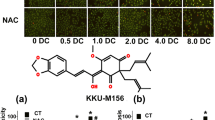We studied the anti-tumor effect of fangchinoline (FAN) against human colorectal cancer cell lines CCL-244 and SW480 and analyzed the mechanism of FAN action. The cell viability and apoptosis were assessed by MTT test and Annexin V-PI staining; caspase-3 activity was measured by Western blotting. The expression of endoplasmic reticulum stress-related proteins was assessed by real-time PCR, Western blotting, and gene transfection. It was found that FAN inhibited cell growth and induced apoptosis in human colorectal cancer cell lines CCL-244 and SW480 in a dose-dependent manner. The caspase-3 inhibitor Ac-DEVD-CHO could reverse the inhibitory effect of FAN. Moreover, FAN significantly increased the expression of endoplasmic reticulum stress-related proteins p-PERK, p-eIF2α, ATF4, and CHOP in CCL-244 and SW480 cells. In addition, endoplasmic reticulum stress inhibitor 4-phenylbutyric acid or CHOP knockdown could prevent FAN-induced apoptosis. Thus, FAN induced apoptosis of human colorectal cancer through activation of endoplasmic reticulum stress.
Article PDF
Similar content being viewed by others
Avoid common mistakes on your manuscript.
References
Petrick JL, Barber LE, Warren Andersen S, Florio AA, Palmer JR, Rosenberg L. Racial Disparities and Sex Differences in Early- and Late-Onset Colorectal Cancer Incidence, 2001-2018. Front. Oncol. 2021;11:734998. https://doi.org/10.3389/fonc.2021.734998
Li Y, Ma Y, Wu Z, Zeng F, Song B, Zhang Y, Li J, Lui S, Wu M. Tumor Mutational Burden Predicting the Efficacy of Immune Checkpoint Inhibitors in Colorectal Cancer: A Systematic Review and Meta-Analysis. Front. Immunol. 2021;12:751407. https://doi.org/10.3389/fimmu.2021.751407
Chan EWC, Wong SK, Chan HT. An overview on the chemistry, pharmacology and anticancer properties of tetrandrine and fangchinoline (alkaloids) from Stephania tetrandra roots. J Integr Med. 2021;19(4):311-316. https://doi.org/10.1016/j.joim.2021.01.001
Rani J, Bhargav A, Khan FI, Ramachandran S, Lai D, Bajpai U. In silico prediction of natural compounds as potential multi-_target inhibitors of structural proteins of SARS-CoV-2. J. Biomol. Struct. Dyn. 2021:1-17. https://doi.org/10.1080/07391102.2021.1968497
Zhang W, Yang S, Liu J, Bao L, Lu H, Li H, Pan W, Jiao Y, He Z, Liu J. Screening antiproliferative drug for breast cancer from bisbenzylisoquinoline alkaloid tetrandrine and fangchinoline derivatives by _targeting BLM helicase. BMC Cancer. 2019;19(1):1009. https://doi.org/10.1186/s12885-019-6146-7
Bao K, Li Y, Wei J, Li R, Yang J, Shi J, Li B, Zhu J, Mao F, Jia R, Li J. Fangchinoline suppresses conjunctival melanoma by directly binding FUBP2 and inhibiting the homologous recombination pathway. Cell Death Dis. 2021;12(4):380. https://doi.org/10.1038/s41419-021-03653-4
Zhang Y, Wang S, Chen Y, Zhang J, Yang J, Xian J, Li L, Zhao H, Hoffman RM, Zhang Y, Jia L. Fangchinoline Inhibits Human Esophageal Cancer by Transactivating ATF4 to Trigger Both Noxa-Dependent Intrinsic and DR5-Dependent Extrinsic Apoptosis. Front. Oncol. 2021;11:666549. https://doi.org/10.3389/fonc.2021.666549
Jung YY, Shanmugam MK, Chinnathambi A, Alharbi SA, Shair OHM, Um JY, Sethi G, Ahn KS. Fangchinoline, a Bisbenzylisoquinoline Alkaloid can Modulate Cytokine-Impelled Apoptosis via the Dual Regulation of NF-κB and AP-1 Pathways. Molecules. 2019;24(17):3127. https://doi.org/10.3390/molecules24173127
Li XH, He XR, Zhou YY, Zhao HY, Zheng WX, Jiang ST, Zhou Q, Li PP, Han SY. Taraxacum mongolicum extract induced endoplasmic reticulum stress associated-apoptosis in triple-negative breast cancer cells. J. Ethnopharmacol. 2017;206:55-64. https://doi.org/10.1016/j.jep.2017.04.025
Hoetelmans R, van Slooten HJ, Keijzer R, Erkeland S, van de Velde CJ, Dierendonck JH. Bcl-2 and Bax proteins are present in interphase nuclei of mammalian cells. Cell. Death Differ. 2000;7(4):384-392. https://doi.org/10.1038/sj.cdd.4400664
Beberok A, Rzepka Z, Respondek M, Rok J, Sierotowicz D, Wrześniok D. GSH depletion, mitochondrial membrane breakdown, caspase-3/7 activation and DNA fragmentation in U87MG glioblastoma cells: New insight into the mechanism of cytotoxicity induced by fluoroquinolones. Eur. J. Pharmacol. 2018;835:94-107. https://doi.org/10.1016/j.ejphar.2018.08.002
Wang H, Dou S, Zhu J, Shao Z, Wang C, Cheng B. Ghrelin mitigates MPP+-induced cytotoxicity: Involvement of ERK1/2-mediated Nrf2/HO-1 and endoplasmic reticulum stress PERK signaling pathway. Peptides. 2020;133:170374. https://doi.org/10.1016/j.peptides.2020.170374
Losada A, Berlanga JJ, Molina-Guijarro JM, Jiménez-Ruiz A, Gago F, Avilés P, de Haro C, Martínez-Leal JF. Generation of endoplasmic reticulum stress and inhibition of autophagy by plitidepsin induces proteotoxic apoptosis in cancer cells. Biochem. Pharmacol. 2020;172:113744. https://doi.org/10.1016/j.bcp.2019.113744
Hu H, Tian M, Ding C, Yu S. The C/EBP Homologous Protein (CHOP) Transcription Factor Functions in Endoplasmic Reticulum Stress-Induced Apoptosis and Microbial Infection. Front. Immunol. 2019;9:3083. https://doi.org/10.3389/fimmu.2018.03083
Guo Y, Guo R, Su Y, Fu J, Wang S, Kong Y, Wu C, Wang J, Tan C, Mo C, Zhao B. The PERK/eIF2α/ATF4/CHOP pathway plays a role in regulating monocrotaline-induced endoplasmic reticulum stress in rat liver. Res. Vet. Sci. 2020;130:237-239. https://doi.org/10.1016/j.rvsc.2020.03.021
Author information
Authors and Affiliations
Corresponding author
Additional information
Translated from Byulleten’ Eksperimental’noi Biologii i Meditsiny, Vol. 174, No. 11, pp. 597-605, November, 2022
Rights and permissions
Springer Nature or its licensor (e.g. a society or other partner) holds exclusive rights to this article under a publishing agreement with the author(s) or other rightsholder(s); author self-archiving of the accepted manuscript version of this article is solely governed by the terms of such publishing agreement and applicable law.
About this article
Cite this article
Jiang, X., Hu, Y., Peng, J. et al. Fangchinoline Exerts Anticancer Effects on Colorectal Cancer Cells by Evoking Cell Apoptosis via Endoplasmic Reticulum Stress. Bull Exp Biol Med 174, 639–646 (2023). https://doi.org/10.1007/s10517-023-05761-x
Received:
Published:
Issue Date:
DOI: https://doi.org/10.1007/s10517-023-05761-x




